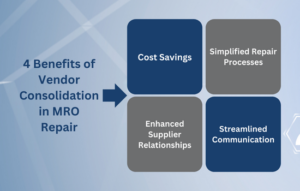In manufacturing, efficiency is everything. Plant professionals are constantly seeking ways to streamline processes, reduce costs, and ensure operational reliability. One increasingly popular strategy to achieve these goals is vendor consolidation. By reducing the number of vendors and centralizing MRO repair management, plant professionals can simplify procurement, enhance supplier relationships, and significantly cut costs. Here’s how vendor consolidation can revolutionize your MRO operations.
Understanding MRO Repair Management
MRO repair management involves the systematic approach to maintaining, repairing, and optimizing machine components in industrial settings. This includes everything from routine maintenance tasks to major overhauls and emergency repairs. Effective MRO repair management ensures that equipment runs smoothly, downtime is minimized, and productivity is maximized.
A critical component of MRO repair management is sourcing the necessary parts and services. Traditionally, plant professionals may work with a multitude of vendors to procure the needed components and services. However, this can lead to inefficiencies, higher costs, and logistical complexities. Instead, maintenance professionals are looking to a new method: vendor consolidation.
The Benefits of Vendor Consolidation
1. Cost Savings
One of the most compelling reasons to consolidate vendors is the potential for significant cost savings. By reducing the number of suppliers, companies can negotiate better pricing and terms due to increased purchasing volume. Bulk industrial repair and purchasing often leads to discounts, and a single, larger contract can provide leverage in negotiations that multiple smaller contracts cannot.
2. Simplified Repair Processes
Managing multiple industrial repair vendors means juggling numerous invoices, contracts, and delivery schedules. Consolidation streamlines MRO repair processes, reducing the administrative burden on professionals within plants. With fewer vendors, the process for industrial repair becomes more straightforward, reducing the risk of errors and delays.
3. Enhanced Supplier Relationships
Fewer vendors mean the opportunity to build stronger, more strategic relationships with key suppliers. These enhanced relationships can lead to better service levels, more reliable delivery schedules, and improved support. Suppliers are more likely to go the extra mile for a valued partner who provides significant business, leading to more favorable terms and quicker resolution of issues.
4. Streamlined Communication
Dealing with numerous vendors can lead to communication challenges and misalignment. Vendor consolidation simplifies communication channels, making it easier to coordinate repairs, track components, and resolve issues. Clear, consistent communication with a limited number of suppliers ensures that everyone is on the same page, reducing misunderstandings and delays.

Implementing Vendor Consolidation for MRO Repair Management
Here are some steps to consider when implementing a vendor consolidation strategy:
1. Assess Current Vendor Landscape
Begin by conducting a thorough assessment of your current vendor landscape. Identify all suppliers, the parts and services they provide, and the costs associated with each. This will give you a clear picture of where consolidation opportunities lie.
2. Evaluate Supplier Performance
Not all suppliers are created equal. Evaluate each vendor based on performance metrics such as reliability, quality, cost, and service. This will help you identify which suppliers are worth keeping and which can be consolidated or replaced.
3. Research/Repair Partners
Working with a repair partner can provide access to a larger network of suppliers while consolidating the number of companies the plant works with directly. This can help the plant find the best supplier for the job each time. Research any partners that may help you consolidate your list of vendors.
4. Engage Stakeholders
Involve key stakeholders from procurement, maintenance, and operations in the consolidation process. Their insights and expertise are invaluable in identifying pain points and potential improvements.
5. Implement and Monitor
Implement your new vendor consolidation strategy and continuously monitor its performance. Regularly review supplier performance and costs to ensure that the consolidation is delivering the expected benefits.
Vendor consolidation in MRO repair offers plant professionals a powerful tool to enhance efficiency, reduce costs, and streamline operations. By centralizing MRO repair management and working with a select group of high-performing suppliers, companies can achieve significant benefits. Simplified repair processes, stronger supplier relationships, and cost savings are just a few of the advantages. In a landscape where operational efficiency and cost-effectiveness are paramount, vendor consolidation stands out as a strategy that can drive substantial improvements.
Contact us at info@ahgroupna.com to learn more about how you can consolidate industrial repair vendors today with AH Group.